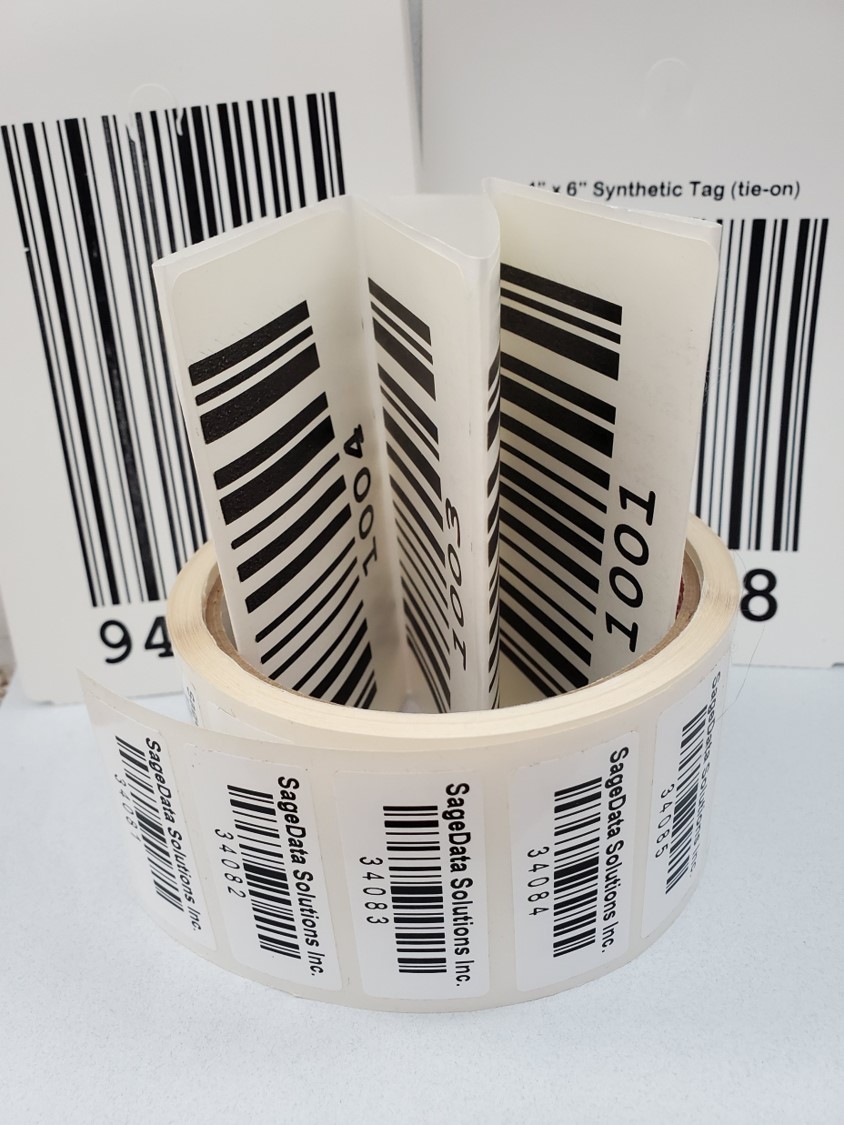Barcode label
best materials
SageData is based in Ottawa, Ontario, Canada
The short answer
The best materials for a barcode label depend on the application.
- If the label is
going to be attached to an asset use polyester.
- If it is going to be used to identify a location, use polyester.
- If it is going to be exposed to the elements, rain and wind, use polyester.
- If it is going to be exposed to solvents, including fuel, use a mylar overlay.
- If it is going to be handled repeatedly, use a mylar overlay.
In most other cases, use paper.
If still unsure, drop us an email, and we give advice. But we might
also offer to print labels for you. Or to supply blank stock. Or offer to sell you a
printer. And even offer the most appropriate software for your specific application.

Polyester Stock
Most of our applications use polyester stock, thermal transfer, pre-printed. These
labels are used for asset management, for tracking IT equipment, laboratory equipment
and furniture. They are used for inspections, including fire prevention equipment. They are
used for tracking laboratory samples, and evidence, providing chain of custody.
In most cases label size is typically 1.5 to 2 inches wide and 0.5 inch to 1 inch
tall. Label contents are usually on 3 lines. The top line is an identifier, often
company or departmental name. The middle line is the barcode, typically a one dimension
symbology, usually code 128. The third line is the barcode content in human readable
format.
Where a UIC (Unique Identification Code) is used, we recommend pre-printed labels. Where
SKU based tracking is used, demand printing is often required. This means that label
contents are not known in advance, and pre-printing is not usually an option. Pre-printed
labels are generally supplied in rolls of one thousand. Lead time is a few days.
Paper Stock
The primary advantage of paper stock is low price. The disadvantage is that the labels
are less robust, more prone to damage. Paper is appropriate for low value items, or items
that have a short life. Paper stock is more appropriate for demand printing.
The process can be as simple as page printing with a laser printer, particularly
appropriate for large volumes where many items need to have the same label. Page printing
with a standard laser printer becomes wasteful when small quantities are required. The
smallest economic quantity is determined by the page size. Demand printers using paper
stock in roll format are available.
Paper stock may be appropriate for some file tracking, though if the file is likely to have
a long life, polyester may be justified. In either case, we recommend pre-printed labels
for file identification. A separate label can be used if file content information is
required.
Just to further confuse the situation around file tracking, we would strongly recommend
that RFID (Radio Frequency
Identification) labelling be considered.
Conclusion
For valuable items, or items with a long tracked
life, use polyester, and where
possible, pre-printed labels. For low value, high quantity items, paper may be a more
economical option. If low volume is required, use a demand label printer with appropriate
software.
We are happy to answer any questions you may have about a specific application that you may be considering.
If you found this useful, you might also want to review:
- barcode scanners, readers and printers
- pre-printed barcode labels
- premium asset tags (micro barcode labels)
- custom barcode labels printing -
a brief
video
QAOK5356
